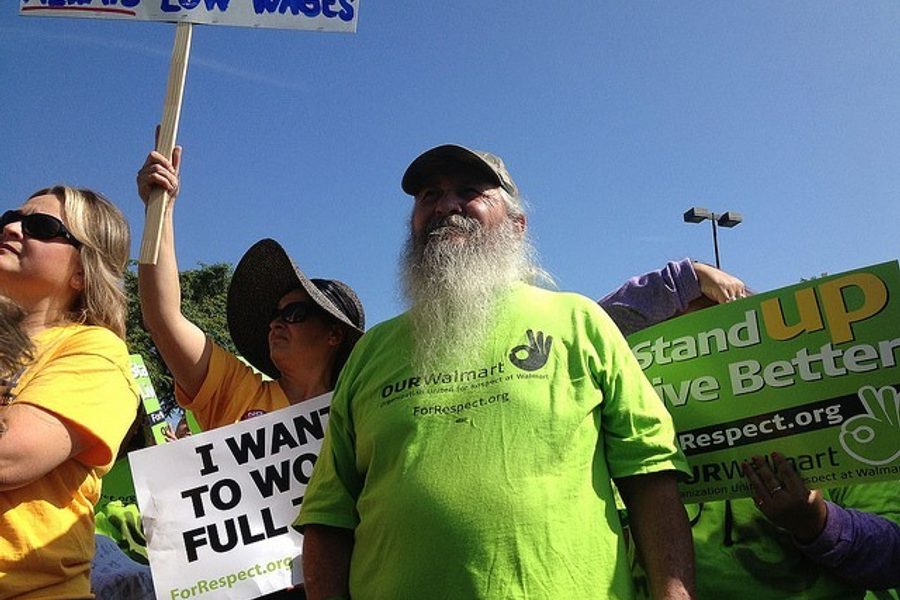Why Walmart, Why Now?
Labor historian Nelson Lichtenstein sheds light on the new surge of Walmart protests.
Micah Uetricht

For years, the world’s retail behemoth, Walmart, has seemed impervious to organizing attempts. Unions, specifically the United Food and Commercial Workers (UFCW), have attempted to organize retail workers at the company — long known for both its low prices and poverty wages — but the company’s aggressive union-busting has always won the day.
So it comes as a surprise to many to hear, seemingly out of the blue, that workers in both the retail and distribution arms of the company have walked off the job in Illinois, Maryland, Dallas, California, and elsewhere over the last month. Striking warehouse workers have organized with Warehouse Workers United in California and Warehouse Workers for Justice in Illinois; retail workers around the country with OUR Walmart—all organizations affiliated with unions, but which aren’t unions themselves.
In These Times asked labor historian Nelson Lichtenstein to shed some light on the recent wave of Walmart worker unrest. Lichtenstein, director of the Center for the Study of Work, Labor and Democracy and a professor of history at the University of California-Santa Barbara, has long observed both Walmart’s business practices and workers’ attempts to organize there. He is the author of The Retail Revolution: How Walmart Created a Brave New World of Business.
There have been past attempts by unions to organize Walmart workers that haven’t gained much traction. What has changed?
Ten years ago, the UFCW went the orthodox organizing route. There were workers who signed union cards, including majorities in some places. But Walmart was extremely good at using existing labor law, which is extremely pro-corporate, to squash it. The UFCW realized that that wasn’t going to work. So OUR Walmart [Organization United for Respect at Walmart] is a kind of return to labor formations of the 1930s. It’s an association – they aren’t looking for legal certification, they don’t claim to represent everyone. They’re a minority that is willing to stick their necks out.
It’s a demonstration strike. For every one worker who actually goes outside and holds a picket sign, you can be sure that 25 workers inside the store or in other stores feel the same way but are afraid to be publicly identified.
What’s remarkable is that this current of pissed-off workers has always existed. But in the past, you could be certain that when a worker, or even an assistant manager, didn’t tow the Walmart line, they would be fired. Not immediately, to stay on the right side of labor law, but within the year, you could be certain they’d be gone.
If, over the next several months, Walmart does not systematically retaliate against these striking workers, it will show other workers that they can stick their necks out. It will embolden other workers to do the same thing. These actions could really be the tip of the iceberg.
Both the retail and the warehouse workers engaged in unfair labor practice strikes—a fairly risky tactic with a high chance of failure.
Well, what’s failure and what’s success? If the strikes are very visible, and workers identify themselves on the picket line outside of Walmart, and those workers keep their jobs for, say, a year afterwards, and there’s no visible retaliation, that’s success.
Now, surely the UFCW knows that they can’t just abandon these workers, and let them be picked off one by one by management over the next year. They need to be right there on top of Walmart, so if people have their hours cut or are put on a lousy shift, they can come back and say, “You are retaliating against concerted protected activity. These workers are protected by labor law — you can’t retaliate against them.”
These retail strikes are happening immediately after Walmart warehouse workers in Elwood, Ill., announced a big victory from their strike: 30 workers who walked off the job in September returned to work on Saturday with full back pay. How important is it that these efforts are focusing on Walmart’s distribution system and retail stores simultaneously?
The competitive advantage of Walmart is their superb distribution system. There are layers of subcontractors, but it’s all one system. It’s a mass sweatshop, where pressure is put through subcontractors to squeeze labor. The industry is the supply chain, regardless of who is the technical employer.
One of the competitive advantages of Walmart is their ability to deploy labor in ways that they refer to as “flexible.” Come in tonight, work three hours tomorrow, etc. For the workers, this is chaos. So a serious organizing success would be if, in the next six months, workers get more predictable shifts, or if store managers think twice before moving someone around from shift to shift.
When workers voted in a union in Quebec and they were actually forced to negotiate with a union, the union did not ask for wage or benefits increases. They simply wanted to give workers predictable shifts — to make it possible for workers to have lives. Instead of doing this, Walmart shut the store down. Walmart was saying, “We cannot operate when workers are sure of a regular shift.”
In an interview for Salon on the strikes, Columbia University Professor Dorian Warren said that the old attempts to organize the company “had been so predictable from Walmart’s point of view,” but that these new forms of organizing to disrupt the distribution chain are a game-changer. Do you agree?
I do. I think if Walmart doesn’t know that these strikes will reappear every so often, that changes things. They have to ask themselves, “Are we going to just have another press release, or are we actually going to change working conditions?” And as I said, if these workers can get away with no retaliation, that will embolden other workers in the future. Lots of labor history takes place in the absence of a union, with informal, subtle pressures. And that’s what’s happening here.
Walmart has emphasized, often aggressively, in some of its PR correspondence that it doesn’t feel threatened by these actions, that this is just business as usual between them and the UFCW. Do you think the company is feeling the heat?
For many years, there has been a kind of rhetorical war between liberals and Walmart about whether the company’s record on a number of issues, from sweatshops in China to the environment. But now, you’ve got actual workers out on strike.
This adds a lot of legitimacy of the critique of Walmart. You need actual Walmart workers, with names and faces, to argue the case against the company. Because that puts the focus right where it should be: on the workers and their lived conditions.
Liberals have always leveled somewhat abstract critiques of Walmart; this strike can make those critiques more concrete.
Yes. The strike takes things beyond the liberal critique of Walmart — which is a fine critique, but it’s not going to solve these problems. Other issues like the environment are important, but the core issue is, what is the character of work at Walmart? Workers aren’t on the picket line because of Walmart’s environmental record, or because of sweatshops in China, both of which are horrible. They’re trying to transform their daily existence. And that’s the core of what the labor movement does.
Micah Uetricht is an editor at Jacobin magazine. He is a contributing editor and former associate editor at In These Times, and the author of Strike for America: Chicago Teachers Against Austerity and coauthor of Bigger Than Bernie: How We Go From the Sanders Campaign to Democratic Socialism, and is currently at work on a book on New Leftists who took jobs in industries like steel and auto to organize on the shop floor.








